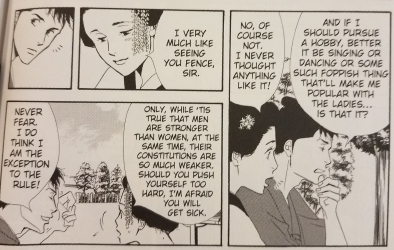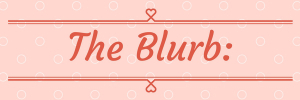Ooku: The Inner Chambers
By: Fumi Yoshinaga
Volumes Available: 13
Elevator pitch: Y the Last Man in ancient Japan.
 Ooku: The Inner Chambers volume 1
Ooku: The Inner Chambers volume 1
One of the weird things about comics I rather enjoy is that you are supposed to judge the book by it’s cover. Sure, the vast majority of comics have a different artist for the cover, but if the cover ends up not having some tenuous connection to the interior, the revolt would be swift. Ooku: The Inner Chambers grabbed me by the cover and didn’t let go.
Ooku begins by showing us how a plague decimates the male population of early 17th century Japan. After about 80 years the population has stabilized but on average there are now four women for each man. Every role traditionally held by men is filled by women, with boys and men jealously guarded for their only purpose: seed-bearers. The Shogun has been a woman for several generations at this point. Thus, her courtesans are all the most handsome and vital men, residing in the Ooku, the Inner Chambers of the Shogun’s palace.
Initially, we follow a young man as he makes his decision to enter the Ooku, Yunoshin Mizuno. He’s clearly in love with his childhood friend, but as she is from a different social class they can never wed. This, and a few other pressures, help his decision to enter a place and service from which he can never leave. Once in the Ooku he must use his surname only. Quickly his martial arts skills help him leapfrog to a high station, avoiding the more normal route of “playing the women” to gain favor with a superior. While both naive to the ways of Ooku and grounded in the reality outside it’s walls, Mizuno reactions to his new world parallel the reader’s quite well. Most of all, I like that he sticks to his guns on every choice he makes and accepts whatever fate may come from it. Mizuno’s serious gaze, highlighted by a touch of red, is part of what I found so captivating about the cover of this volume.
About half way through the book, our second protagonist is introduced: the new Shogun Yoshimune Tokugawa. It’s only for the last quarter of the book that we start to follow her instead of Mizuno. She’s frugal and harsh in executing her policies, but she attempts to be fair in her decisions. I’m amused by how she defies expectations, such as ambushing the gardener and having sex with him in some bushes. As such, she has no qualms about taking steps to slash the budget of the Ooku, dressing more plainly, and constantly questioning why things are a certain way, to the disapproval of just about everyone else. Her driving need to learn how it came to be that a woman answers to both a masculine and feminine name, among other weird traditions, is what leads us into the next volumes. Yoshimune is a character that I look forward to following as she unearths truth while balancing protecting her country and people.
The setting of Ooku really is a bit to wrap your head around, particularly as a non-Japanese person. Just having a frame of reference that the Tokugawa era included the year 1716, or 40 years before Alexander Hamilton was born, is greatly helpful. I would prefer more information on locations and other characters/stations mentioned by name only in the story. Even with the characters we do see regularly, there’s no indication of if that was a real person or not, which is entirely possible. Without the knowledge from even a Japanese middle-school history class, any expectations the creator might have wanted to subvert don’t exist for a western reader. The translator notes in the back help on a few things, but mostly I find myself relying entirely on context to glean what is happening. (Side note: I hate it when translator notes are in white text on black paper.) Yoshinaga does a good job of creating context, and the translation into something that feels Ye-Olde-English-y works for the setting. Still, some extra hand-holding with the notes would have been appreciated. Be prepared to do a bit of googling if you really want to understand the actual history behind this story.
 Interior art from volume 1
Interior art from volume 1
Going back to the cover, I think the illustration and design are phenomenal. Wonderfully, the skill and craftsmanship of the cover image is not lost when you open this book. Yoshinaga relies mainly on clean slim black lines, so when there is some screen tone or speed lines or open space, you feel the impact. I will say that in crafting faces she sometimes is too subtle in what differentiates them, and it is easy to confuse characters. She does have an amazing sense of panel layout. In particular, how she uses small panels to indicate quick glances between characters or emphasize some detail. In general, there’s great craftsmanship to the design and layout of every page. I would recommend this to readers who might have a harder time with books in the right-to-left format.
Beyond that, Yoshinaga has clearly done her homework on traditional designs and patterns from the Tokugawa Shogunate era. Since this is essentially a palace-intrigue drama, appearance is everything, down to the thread used to weave an outer jacket. A great example is Mizuno’s choice of understated black garments for meeting the Shogun rather than something flashy. This makes him stand out amongst a sea of loud patterns and handsome faces. While there’s not much time spent on it, this book is set in a world where design and aesthetics are king. This one’s for you, design nerds.
The Ooku is certainly an unusual world, a place where nothing is what it seems and everything else is upside down. Each character feels like a real person (which they might have been!), and most keep their true goals close to their chests. While deftly weaving a story that helps guide the audience in this setting, there are hints at a larger mystery behind the Ooku that remains compelling. I want to nitpick the art, but in reality the lack of translator notes bugs me more. For a historical drama set in a context I have only the most vague understanding of, Ooku is a visual feast that keeps me captivated.
Art: 4/5
Characters: 4/5
Story: 3.5/5
World: 2.25/5
Overall: 3.5/5
Advertisements Share this:





